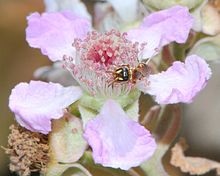Rubus ulmifolius subsp. sanctus
| Rubus ulmifolius subsp. sanctus | |
|---|---|

| |
| Flower with a bee (Hylaeus rubicola) | |
| Scientific classification | |
| Kingdom: | Plantae |
| Clade: | Tracheophytes |
| Clade: | Angiosperms |
| Clade: | Eudicots |
| Clade: | Rosids |
| Order: | Rosales |
| Family: | Rosaceae |
| Genus: | Rubus |
| Species: | |
| Subspecies: | R. u. subsp. sanctus
|
| Trinomial name | |
| Rubus ulmifolius subsp. sanctus | |
| Synonyms[2][3] | |
Rubus ulmifolius subsp. sanctus, commonly called holy bramble,bramble native to parts of Asia and Europe.[2]
This plant is very long-lived. An instance of it can be found at the Chapel of the Burning Bush on Mount Sinai, where it is revered as the original burning bush of the Bible. This longevity and location lead to its Latin name.[5][6]

Chemistry
3,6-Di-O-caffeoylglucose, 1-O-caffeoylxylose and 2,3-O-hexahydroxydiphenoyl-4,6-O-sanguisorboyl-(α/β)-glucose (an ellagitannin constituted with sanguisorbic acid), are found in R. ulmifolius subsp. sanctus.[7]
References
- ^ "Tropicos". www.tropicos.org.
- ^ a b "Rubus sanctus". Germplasm Resources Information Network. Agricultural Research Service, United States Department of Agriculture. Retrieved 16 January 2018.
- ^ "Rubus ulmifolius subsp. sanctus (Schreb.) Sudre — The Plant List". www.theplantlist.org.
- ^ "Rubus sanguineus". Wildflowers of Israel.
- ^ "Places of Peace and Power". Retrieved 15 October 2014.
- ^ "Chapel of the Burning Bush". Retrieved 15 October 2014.
External links
Wikimedia Commons has media related to Rubus sanguineus.
